Adolph Alexander Weinman
Adolph Alexander Weinman (December 11, 1870 – August 8, 1952) was a German-born American sculptor and architectural sculptor.
Adolph Alexander Weinman | |
|---|---|
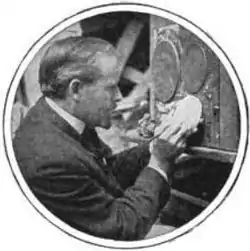 Adolph Weinman, circa 1917. | |
| Born | December 11, 1870 |
| Died | August 8, 1952 (aged 81) Port Chester, New York, U.S. |
| Nationality | German-American |
| Education | Cooper Union Art Students League of New York |
| Known for | Sculpture |
Life

Born in Durmersheim, near Karlsruhe, Germany, Weinman arrived in the United States at the age of 14. At the age of 15, he attended evening classes at Cooper Union and later studied at the Art Students League of New York with sculptors Augustus Saint-Gaudens and Philip Martiny. He later served as an assistant to Charles Niehaus, Olin Warner, and Daniel Chester French. Weinman opened his own studio in 1904.[1] Although Weinman is now best remembered as a medalist, when he once was introduced as such he vehemently denied being one and said that he was an architectural sculptor.[2] His steadiest income was derived from the sale of small bronze reproductions of his larger works, such as Descending Night, originally commissioned for the Panama-Pacific International Exposition, San Francisco, 1915.[3]
Weinman was a member of the National Sculpture Society and served as its president from 1927 to 1930. His work was also part of the sculpture event in the art competition at the 1928 Summer Olympics.[4] He served on the U.S. Commission of Fine Arts from 1929 to 1933.[5] He was also a member of the American Academy of Arts and Letters, the National Institute of Arts and Letters, the National Academy of Design, and the New York City Art Commission, among other organizations.[1]
Weinman died in Port Chester, New York, on August 8, 1952. Following a mass at Manhattan's St. Patrick's Cathedral, he was buried at Calvary Cemetery in Queens. Weinman's papers are at the Smithsonian Archives of American Art.
His son Robert Weinman was also a sculptor.
Work

Despite his objections, Weinman is still best remembered as the designer of the Walking Liberty Half Dollar (a design now used for the obverse of the American Silver Eagle one-ounce bullion coin) and the "Mercury" dime along with various medals for the Armed Services of the United States. Among these are the identical reverses of the Asiatic-Pacific Campaign Medal, the European-African-Middle Eastern Campaign Medal, and the American Campaign Medal. Weinman was one of many sculptors and artists who employed Audrey Munson as a model.
As an architectural sculptor, Weinman's work can be found on the Wisconsin, Missouri, and Louisiana state capitol buildings. He became the sculptor of choice for the architectural firm McKim, Mead, and White and designed sculpture for their Manhattan Municipal Building, Madison Square Presbyterian Church (demolished), Prison Ship Martyrs' Monument, and the since-demolished Pennsylvania Railroad Station, all in New York City. A photograph of one of his angels, Day, in a landfill in New Jersey is one of the saddest reminders of the destruction of Penn Station in 1963, but two of his eagles were retained as trophies outside the entrance to the new subterranean Penn Station.[6] Elsewhere he created the dramatic frieze on the Elks National Veterans Memorial in Chicago and executed sculpture for the Post Office Department Building, the Jefferson Memorial, and the interior of the U.S. Supreme Court, all in Washington, D.C.
Weinman's non-architectural works include the Macomb and the Maybury monuments in Detroit.[7] Another example of his non-architectural work is his Abraham Lincoln Statue (Kentucky) located in the center of Hodgenville, Kentucky.[8]
Weinman was one of 250 sculptors who exhibited in the 3rd Sculpture International held at the Philadelphia Museum of Art in the summer of 1949.
Weinman's works are mostly executed in a lyrical neoclassical style. His figures typically wear classical drapery, but there is a fluidity found in his work that is a harbinger of the Art Deco style that was to follow him. His bronze statuette The Nude Golfer epitomizes this style. This work evokes classical sculpture in its attention to anatomy and movement and the nude status of the athlete while the subject, a modern golfer, provides a modern twist.[9]
Weinman also taught; among his pupils was Eleanor Mary Mellon.[10]
Selected works
Sculpture
- General Alexander Macomb (1906–1908), Detroit, Michigan.[7][11][12]
- Union Soldiers and Sailors Monument (1909), Wyman Park, Baltimore, Maryland.
- Abraham Lincoln (1909), Hodgenville, Kentucky. A replica of this is at the University of Wisconsin–Madison.
- Alexander Johnston Cassatt, (1910), Pennsylvania Station, New York City.[1]
- Abraham Lincoln (1911), Kentucky State Capitol, Frankfort, Kentucky.
- William Cotter Maybury Memorial (1912), Grand Circus Park, Detroit, Michigan.
- Rising Sun (1914–15), Panama-Pacific International Exposition, San Francisco, California.
- Descending Night (1914–15) (model, Audrey Munson), Panama-Pacific International Exposition, San Francisco, California.
- Samuel Rea (1926), Pennsylvania Station, New York City.[1]
- Fountain of the Centaurs (ca. 1926), Missouri State Capitol, Jefferson City, Missouri.
- Pair of Lions (1929–30), Baltimore Museum of Art, Baltimore, Maryland.
- Dewitt Clinton (1941) and Alexander Hamilton (1941), Museum of the City of New York, New York City.
- Riders of the Dawn (ca. 1942), Brookgreen Gardens, Murrell's Inlet, South Carolina.
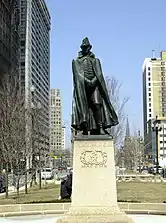
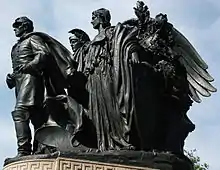
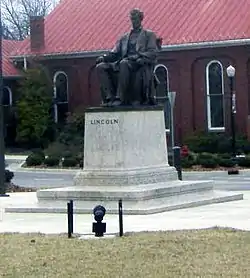

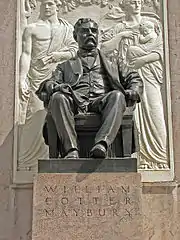 William Cotter Maybury Memorial (1912), Grand Circus Park,
William Cotter Maybury Memorial (1912), Grand Circus Park,
Detroit, Michigan
 Civic Fame (1913), atop Manhattan Municipal Building,
Civic Fame (1913), atop Manhattan Municipal Building,
New York City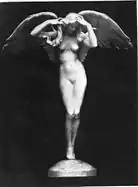 Descending Night (1914–15), Panama-Pacific International Exposition,
Descending Night (1914–15), Panama-Pacific International Exposition,
San Francisco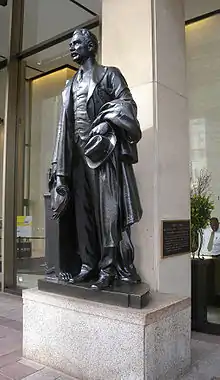 Samuel Rea (1926), Pennsylvania Station,
Samuel Rea (1926), Pennsylvania Station,
New York City.
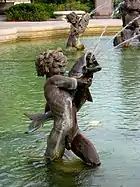
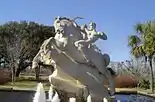
 One of the four Adolf Weinman eagles of the Prison Ship Martyrs' Monument
One of the four Adolf Weinman eagles of the Prison Ship Martyrs' Monument One of four bronze eagle sculptures surrounding the Prison Ship Martyrs' Monumentin the Fort Greene Historic District
One of four bronze eagle sculptures surrounding the Prison Ship Martyrs' Monumentin the Fort Greene Historic District
Architectural sculpture
- Architectural sculpture (1903–04), Pennsylvania Station, McKim, Mead and White, architects, (demolished 1964). Salvaged pieces of statuary survive in multiple locations.
- Architectural sculpture (1904–1906), Madison Square Presbyterian Church, New York City, McKim, Mead and White, architects, (demolished 1919).
- Architectural sculpture (1908), Prison Ship Martyrs' Monument, Fort Greene Park, Brooklyn, New York City, McKim, Mead and White, architects.
- Masonic Sphinxes: Power and Wisdom (1911–1915), House of the Temple, Washington, D.C., John Russell Pope, architect.
- Architectural sculpture (1913–1915), Manhattan Municipal Building, New York City, McKim, Mead and White, architects.
- Bronze doors (1921–1923), American Academy of Arts and Letters administration building, West 155th Street, Audubon Terrace, Manhattan, New York City.
- Architectural sculpture (1924–1926), Elks National Veterans Memorial, Chicago, Illinois.
- Architectural sculpture: South Pediment (ca. 1926), Missouri State Capitol, Jefferson City, Missouri.
- Architectural sculpture: Destiny Pediment (1935), National Archives Building, Washington, D.C.
- Drafting the Declaration of Independence (1939–1943), pedimental sculpture honoring the Committee of Five on the Jefferson Memorial, Washington, D.C.
 Pennsylvania Station, New York City (1903–04, demolished 1964)
Pennsylvania Station, New York City (1903–04, demolished 1964)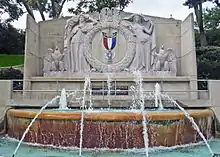 Eagle Scout Memorial Fountain (1968), Kansas City, Missouri. Salvaged pieces from Pennsylvania Station,
Eagle Scout Memorial Fountain (1968), Kansas City, Missouri. Salvaged pieces from Pennsylvania Station,
New York City


 Detail, bronze doors, American Academy of Arts and Letters West 155th Street entrance, (1921–1923)
Detail, bronze doors, American Academy of Arts and Letters West 155th Street entrance, (1921–1923)
New York City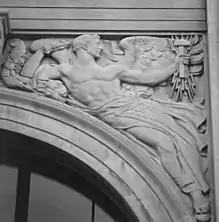
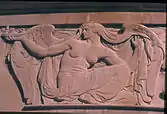
.JPG.webp) Destiny Pediment (1935), National Archives Building,
Destiny Pediment (1935), National Archives Building,
Washington, D.C. Drafting the Declaration of Independence Pediment (1939–1943), Jefferson Memorial,
Drafting the Declaration of Independence Pediment (1939–1943), Jefferson Memorial,
Washington, D.C.
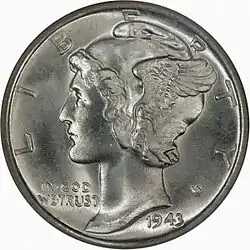
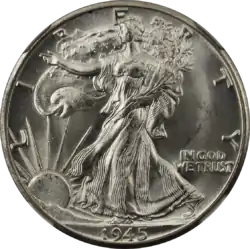
U.S. coins and medals
- Mercury dime (1916–1945). More than 2 billion Mercury dimes were minted before it was replaced by the Roosevelt dime in 1946.[13] The design is now used as the obverse of the American Palladium Eagle coin, which has been produced since 2017.
- Walking Liberty half dollar (1916–1947). Replaced by the Franklin half dollar (1948). Weinman's carving is now used as the obverse of the American Silver Eagle coin, which has been produced since 1986.
- J. Sanford Saltus Medal Award – awarded by the American Numismatic Society. Weinman was the second recipient of this medal.
References
Notes
- "About the Adolph A. Weinman Papers". Smithsonian Archives of American Art. Retrieved March 27, 2010.
- Reiter, Ed (January 31, 2000). "The Weinman Legacy–Part 1". PCGS Library. Archived from the original on May 16, 2011. Retrieved March 27, 2010.
- Descending Night Metropolitan Museum of Art, acc. no. 1994.501
- "Adolph Alexander Weinman". Olympedia. Retrieved 29 July 2020.
- Luebke, Thomas E. (ed.) Civic Art: A Centennial History of the U.S. Commission of Fine Arts (Washington, D.C.: U.S. Commission of Fine Arts, 2013): Appendix B, p. 557.
- One is illustrated in Walsh, Kevin. Forgotten New York: The Ultimate Urban Explorer's Guide to All Five Boroughs, 2006:169: "Others can be found in Kings Point and Hicksville and as far away as Philadelphia".
- Zacharias, Pat (September 5, 1999). "The Monuments of Detroit". The Detroit News. Archived from the original on July 10, 2012. Retrieved March 27, 2010.
- Federal Writers' Project (1996). The WPA Guide to Kentucky. University Press of Kentucky. p. 120. ISBN 0813108659. Retrieved 24 November 2013.
- "Adolph Alexander Weinman". Fine Art, May 2007. Rago Arts and Auction Center. Archived from the original on 2011-07-15.
- Jules Heller; Nancy G. Heller (19 December 2013). North American Women Artists of the Twentieth Century: A Biographical Dictionary. Routledge. ISBN 978-1-135-63882-5.
- "Statue of General Alexander Macomb". January 4, 2009. Retrieved March 27, 2010.
- Lloyd, Marshall Davies (August 20, 2006). "Navarre Arms: The Navarres of Meaux and New France". Retrieved August 3, 2016.
- Lange, David W. A Complete Guide Book to Mercury Dimes (Virginia Beach, Va.: DLRC Press, 1993). ISBN 978-1-880731-17-8.
Bibliography
- Kvaran and Lockley, A Guide to the Architectural Sculpture of America, unpublished manuscript
External links
| Wikimedia Commons has media related to Adolph Alexander Weinman. |
| Wikisource has the text of a 1920 Encyclopedia Americana article about Adolph Alexander Weinman. |
- Works by or about Adolph Alexander Weinman at Internet Archive
- Adolph A. Weinman Papers at the Smithsonian Archives of American Art
- Artist page at the Metropolitan Museum of Art
- Adolph Weinman - Master Engraver
- A.A. Weinman (1870-1952) at the R. W. Norton Art Gallery
- Adolph Alexander Weinman at Find a Grave